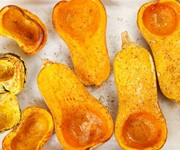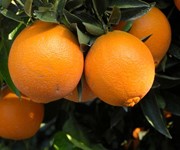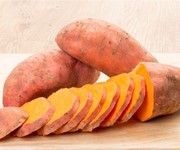The best orange foods
We pick a lovely autumnal colour and focus our foodie efforts on it. Last time it was purple, but today we're focusing on five wonderful ORANGE foods.
Butternut squash
 What is it? A type of winter squash with soft flesh and a sweet taste. It’s incredibly versatile to cook with and can even be used to sweeten cakes in its pulped form. It’s actually a fruit by definition, and it grows on a (very study) vine. It’s a great source of fibre, vitamin C, magnesium and potassium.
What is it? A type of winter squash with soft flesh and a sweet taste. It’s incredibly versatile to cook with and can even be used to sweeten cakes in its pulped form. It’s actually a fruit by definition, and it grows on a (very study) vine. It’s a great source of fibre, vitamin C, magnesium and potassium.
In season: From November to January.
Fun fact: Waltham butternut squash (the most popular butternut squash variety) was actually developed by a scientist in an experiment station in Massachusetts.
How to eat it: Blitz it into a soup, roast it in quarters with a little rosemary and oil, make our risotto recipe, or try a butternut squash kutta.
My best butternut squash memory: Cutting one in half, roasting in the oven, and filling the gap with a leek cheese sauce… an entirely edible fondue for two.
Mango
 What is it? A sweet, fragrant, juicy fruit, with an abnormally large stone in the centre. It’s native to the Indian subcontinent and is in fact the national fruit of India, the Philippines and Pakistan. You might find its fruit and leaves used as floral decorations at weddings and religious ceremonies in some cultures, too. It’s the fruit most likely to dribble down your chin. Apart from peaches, perhaps.
What is it? A sweet, fragrant, juicy fruit, with an abnormally large stone in the centre. It’s native to the Indian subcontinent and is in fact the national fruit of India, the Philippines and Pakistan. You might find its fruit and leaves used as floral decorations at weddings and religious ceremonies in some cultures, too. It’s the fruit most likely to dribble down your chin. Apart from peaches, perhaps.
In season: Summertime, in India.
Fun fact: Apparently, mangoes are the world’s most popular fruit.
How to eat it: Au natural is best, we think. It’s such an incredible flavour on its own that there’s no real need to serve it with anything else. However, we do have a rather tempting mango cream cake recipe, made by a MasterChef winner…
My best mango memory: Eating several in the garden on a very hot August day last year – so refreshing!
Wotsits

In season: Every single day of the year.
Fun fact: Wotsits used to be fried like normal crisps, but in 2007 Walkers decided to bake them instead. So now they’re only 99 calories a bag!
How to eat it: Not with gloves on. I made that mistake once, and I never got the luminous orange cheese powder off them.
My best wotsits memory: Eating a bag next to the swimming pool in Crete, whilst listening to ABBA on my cassette player. Sheer bliss for a 7-year-old.
Big orange
 What is it: Well, an orange. But more specifically, a ‘navel orange’ – the biggest ones on sale at the supermarket. You very rarely see people peeling them nowadays (too much faff, perhaps), which is a shame because they taste so fantastic.
What is it: Well, an orange. But more specifically, a ‘navel orange’ – the biggest ones on sale at the supermarket. You very rarely see people peeling them nowadays (too much faff, perhaps), which is a shame because they taste so fantastic.
In season: Navel oranges actually ripen in the winter and are in season from November to March.
Fun fact: Navel oranges are called so, because usually a second fruit grows at the apex of the orange. This mini fruit protrudes slightly and resembles a human navel… nice!
How to eat it: Roll your sleeves up, peel over the sink, and have some kitchen towel on hand to wipe juicy fingers. It really is worth the effort. Or, if you’re feeling lazy, just slice a whole orange into ‘orange boats’, and eat from the peel. Why not serve slithers with pistachios and honey for a dinner party?
My best orange memory: A giant navel orange form M&S was the first thing I ate after I passed my shorthand exam. I know how to celebrate.
Sweet potato
 What is it? A large, starchy root vegetable with a sweet taste and elongated shape. It doesn’t taste anything like a potato and its flesh can be purple, pink, violet, yellow and white – but we Brits mainly get it in its orange form. Its texture is creamy and, believe it or not, they are often baked and topped with marshmallows at the American Thanksgiving table. They’re a great source of vitamins A and C.
What is it? A large, starchy root vegetable with a sweet taste and elongated shape. It doesn’t taste anything like a potato and its flesh can be purple, pink, violet, yellow and white – but we Brits mainly get it in its orange form. Its texture is creamy and, believe it or not, they are often baked and topped with marshmallows at the American Thanksgiving table. They’re a great source of vitamins A and C.
In season: All year round, although more readily during the cooler months.
Fun fact: Due to their high levels of vitamin A and beta-carotene, sweet potatoes are great for the skin.
How to eat it: Bake them like you would jacket potatoes, puree and use as a sugar substitute in baking, chop into wedges and roast with oil, or stuff them with spicy sausage.
My best sweet potato memory: The sweet potato wedges with sour cream at Mildreds in Soho, London. Divine.
Wotsits image courtesy of Delusion23
You might also like
Comments
Be the first to comment
Do you want to comment on this article? You need to be signed in for this feature